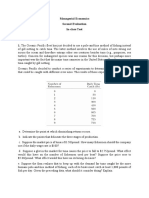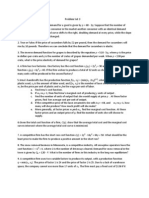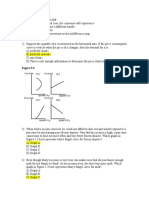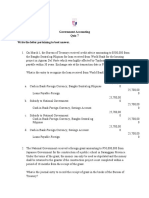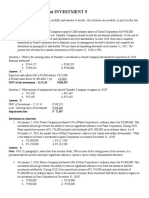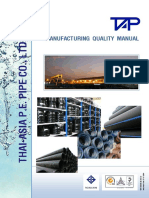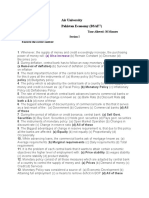Economics 201D –Fall 2022 – Midterm 2 Name:________________________________
This exam has 3 questions. Two pages are provided for your answer to each question. Place your final
answers on the two pages intended for each question. Scratch paper is attached at the end for you to
work on before you transfer answers to the answer sheets. You do NOT need to provide explanations for
your answers unless the question specifically asks for an explanation – and any explanations that were
not asked for will not be graded. If an explanation is requested, a brief explanation is all that is needed.
Put your name (legibly) on each answer sheet in the space provided. There are 100 points on the exam.
The total number of points for each part is indicated in each question.
Throughout the exam, assume all production technologies are homothetic, that labor is always variable
while capital is fixed in the short run, and that labor and capital are neither perfectly substitutable nor
perfectly complementary in production. Throughout this exam, assume all firms are identical and small
relative to the market and that the market is perfectly competitive.
In questions 2 and 3 (BUT NOT IN QUESTION 1), suppose restaurants have the production function
𝑥 = 4.472𝑙!/# 𝑘!/$ .
This implies that they have input demand functions
%! %!
𝑙(𝑤, 𝑟, 𝑝) = 55.56 1 2 and 𝑘(𝑤, 𝑟, 𝑝) = 37.04 1 2,
&"'# &$'$
and an output supply function
%%
𝑥(𝑤, 𝑟, 𝑝) = 111.11 1& $ ' #2.
The restaurants’ input demands conditional on trying to reach output level x are
' #/( & $/(
𝑙(𝑤, 𝑟, 𝑥) = 0.1949 1& 2 𝑥 )/( and 𝑘(𝑤, 𝑟, 𝑥) = 0.1299 1 ' 2 𝑥 )/( ,
and the long run cost function is
𝑐(𝑤, 𝑟, 𝑥) = 0.3248𝑤 $/( 𝑟 #/( 𝑥 )/( + 𝐹𝐶
where FC is a recurring fixed cost.
1
�Economics 201D – Fall 2022 – Midterm 2
1. (33 points) Ethel owns a restaurant in NYC where there are lots of similar restaurants. Restaurants
use labor (l) and capital (k) as inputs to produce meals (x), and the production function for meals in
restaurants has initially increasing returns to scale up to x’ and eventually decreasing returns to scale
past x’. Initially, labor can be hired at a wage of $15 and capital at a rental rate of $20. At the initial
long run equilibrium, restaurants serve 2,400 meals (per week) using 2,400 labor hours (per week)
and 1,800 units of capital (per week), and the price per meal is $30. (Do not refer to the equations on
page 1 for this question.)
a. If you were to add the isoquant for x’, would it
lie above or below the isoquant that is
illustrated? (2 points)
b. What labeled production plan is Ethel currently
producing? (2 points)
c. What is the marginal product of labor and what
is the marginal product of capital at this initial
production plan? (4 points)
d. With the information provided, can you tell
whether the long run average cost curve is U-
shaped? If so, draw the long run average cost
curve and label the horizontal and vertical
component of the lowest point if it is U-shaped.
If not, why are you not able to tell whether the curve is U-shaped? (3 points)
e. With the information provided, can you tell whether the short run average cost curve is U-
shaped? If so, draw the approximate shape of the short run average cost curve and label the
horizontal and vertical component of the lowest point if it is U-shaped. If not, why are you not
able to tell whether the curve is U-shaped? (3 points)
f. Because of the current labor shortage, the wage that restaurants have to pay increases to $20. At
first, Ethel believes that other restaurants are unaffected by this wage increase – and only she has
to pay a higher wage to retain her employees. As a result, she plans to switch to the production
plan labeled B in the short run. Can you tell what marginal product of labor and marginal
product of capital is at B? If so, provide the numerical answer(s). If not, briefly explain why you
cannot tell. (4 points)
g. When Ethel realizes that all restaurants have to pay the higher wage, she changes what she plans
to do in the short run. In side-by-side graphs with the restaurant market on the left and Ethel’s
relevant cost curves on the right, illustrate the short run quantity 𝑥* Ethel would produce if the
wage increase only happened to her restaurant and the actual quantity x* Ethel will produce in
the short run given that everyone has to pay the higher wage. What labeled production plan(s)
might she now choose in the short run equilibrium? (6 points)
h. After the restaurant market has had a chance to settle into a new long run equilibrium following
the increase in wages, you visit Ethel and learn that she is hiring just as much labor now as she
was in the initial long run equilibrium before the wage increase. What labeled production plan(s)
might she be using in the new long run equilibrium? (2 points)
i. From what you have discovered about Ethel, can you tell whether the number of restaurants in
the industry has increased or decreased? If so, indicate whether the number of restaurants
increased or decreased. If not, state what else you would have to know to be sure. (4 points)
j. In parts (g) and (h), you chose labeled production plans in the graph that Ethel might choose in
the short run equilibrium and the long run equilibrium. If these are indeed the production plans
she chooses, is the marginal revenue product of capital equal to the rental rate for Ethel in the
short run equilibrium? Briefly explain. (3 points)
2
�Economics 201D – Fall 2022 – Midterm 2
2. (33 points) In this question, refer to page 1 of the exam for any equations you might need. Ignore
anything question 1 said about the production technology of restaurants and instead suppose all
restaurants have the same underlying production function 𝑥 = 4.472𝑙!/# 𝑘!/$ . In addition, assume all
restaurants incur a recurring fixed cost FC. The restaurant market is initially in long run equilibrium
with w=$20, r=$20 and p=$34.64. Throughout the question, round your answers to the nearest
integer.
a. Can you tell whether restaurants have increasing or decreasing returns to scale? If so, state your
answer. If not, indicate what else you would have to know to be able to tell. (2 points)
b. Can you tell whether restaurants ever experience increasing marginal product of labor? If so,
state your answer. If not, indicate what else you would have to know to be able to tell. (2 points)
c. In the isoquant graph, what is the numerical
label of the isoquant that is not labeled? (2
points)
d. The ray that is drawn from the origin through A,
B and C represents Cletus’ current cost
minimizing ray. What is the labor and capital
level in the production plan C? (4 points)
e. What labeled production plan is profit
maximizing for Cletus under the current input
and output prices? Use at least one of the
equations to justify your answer. (4 points)
f. Approximately what must the recurring FC be
for this to be the profit maximizing production
plan in the long run competitive equilibrium?
Show how you calculated this. (4 points)
g. Concerned that the wage of $20 is too high for restaurants to survive, the government introduces
a wage subsidy that reduces the wage all restaurants have to pay to $15. As a result, you observe
that the short run equilibrium meal price is $31.50. How much labor will Cletus use in the short
run, and how many meals will he serve in the short run? Show your work. (8 points)
h. When we reach the new long run equilibrium, you find that the price per meal has fallen from
the initial $34.64 to $30. How many meals is Cletus serving in the new long run equilibrium? (3
points)
i. Given the short run and long run equilibrium prices after the wage subsidy, can you tell (without
doing any additional math) whether the number of restaurants in the market has gone up or down
as a result of the wage subsidy? If so, briefly explain. If not, what else would you have to know
in order to be able to tell? (4 points)
3
�Economics 201D – Fall 2022 – Midterm 2
3. (34 points) In this question, refer to page 1 of the exam for any equations you might need. Ignore
anything question 1 said about the production technology of restaurants and instead suppose all
restaurants have the same underlying production function 𝑥 = 4.472𝑙!/# 𝑘!/$ . In addition, assume all
restaurants incur a recurring fixed cost FC. In this question, assume the market demand for restaurant
meals is given by
𝑋(𝑝) = 3,000,000𝑝+! .
Throughout this question, round answers about restaurant meals and numbers of firms to the nearest
integer and prices to two decimal places.
a. Suppose the wage is $15 and the rental rate is $20. Derive (from the relevant equation on page 1)
the equation for the cost curve that illustrates the long run cost of producing as a function of just
output x and the recurring fixed cost FC given this wage and rental rate. (2 points)
b. Use your answer to (a) to derive the long run average cost function (given w=15 and r=20) as a
function of x and FC. (2 points)
c. If the restaurant industry is in long run equilibrium, how much will each restaurant produce as a
function of FC? How many meals will each restaurant serve if FC=10,000? Show your work. (6
points)
d. What is the long run equilibrium price if FC =10,000, and how many restaurants are operating in
this market in the long run equilibrium? (4 points)
e. Suppose the government wants to increase labor employment in the restaurant business by
giving incentives for more restaurants to enter the market. It therefore commits to paying $5000
of each restaurant’s recurring FC from now on. If you now re-calculate the long run equilibrium
(using the same method you used above), you would get that (in the new long run equilibrium)
each restaurant serves 1,123 meals, the price per meal is $26.725 and the number of restaurants
in the market is 100. How many labor hours is each restaurant hiring when the FC is 10,000 and
how many labor hours is each restaurant hiring in the long run when the FC is 5,000? (4 points)
f. How many labor hours are hired in the restaurant market when FC is 10,000 and when FC is
5,000? Will the government succeed in raising labor employment in the restaurant industry by
reducing the FC from 10,000 to 5,000? Briefly explain. (5 points)
g. Suppose that (instead of lowering the recurring FC) the government provides restaurants with a
per-meal subsidy of $3.275. Illustrate in side-by-side graphs, with the restaurant market on the
left and one restaurant’s relevant cost curves to the right, what will happen (in the long run) to
the price of meals, the number of meals served in each restaurant and the total number of
restaurants? (You do not need to use any equations in this part – just a graph.) (6 points)
h. Approximately how many restaurants will there be in the industry in the long run under the per-
meal subsidy? What will be total labor employment in the industry? If the purpose of the policy
was to raise labor employment in the restaurant market, which policy would you recommend –
lowering FC to $5000 or providing a per-meal subsidy of $3.275? Briefly explain. (5 points)
4
�Economics 201D – Fall 2022 – Midterm 2 Name:________________________________
I pledge to obey the Duke University Honor Code during this exam.
Signed: ________________________________________
Answer to Question 1
5
�Economics 201D – Fall 2022 – Midterm 2 Name:________________________________
Answer to Question 1 (continued)
6
�Economics 201D – Fall 2022 – Midterm 2 Name:________________________________
Answer to Question 2
7
�Economics 201D – Fall 2022 – Midterm 2 Name:________________________________
Answer to Question 2 (continued)
8
�Economics 201D – Fall 2022 – Midterm 2 Name:________________________________
Answer to Question 3
9
�Economics 201D – Fall 2022 – Midterm 2 Name:________________________________
Answer to Question 3 (continued)
10
�SCRATCH PAPER – DO NOT HAND IN
11
�SCRATCH PAPER – DO NOT HAND IN
12
�SCRATCH PAPER – DO NOT HAND IN
13






























